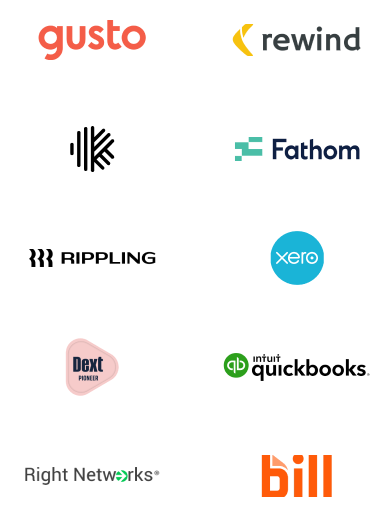Accounting For Restaurants – Served On A Plate
Focus on delighting your customers while our restaurant bookkeeping solutions provide precise financial tracking, enhanced cash flow controls, and clear, insightful financial reports tailored to the restaurant industry.
Trusted by hundred of businesses



How Can We Help?
Equipped to cater to all the accounting challenges your restaurant has
Running a restaurant’s operations is already complex, and shouldn’t be made more complicated by hiring generic bookkeeping services. That is why we provide restaurant bookkeeping services tailored to the specific needs of a culinary business, from tracking daily sales and managing expenses to preparing detailed financial statements with accuracy and attention.
Expense Management
We help you spot spending trends beforehand, using bookkeeping software for restaurants that manage, monitor, and categorize every restaurant expense, including food and beverage costs and equipment purchases.
Revenue Tracking
We track your daily sales, special promotions, and online orders in real time using accounting software for restaurants, so you can see what is selling, spot trends, and quickly follow up on any missed payments.
Inventory Management Reporting
We provide you with detailed and accurate reports on your food and beverage inventory, and help you track usage, calculate food costs, and reduce waste. Our insights help you order just what you need and keep your kitchen running efficiently.
Tax Filing and Compliance
We make sure that your restaurant stays in line with the best bookkeeping services for restaurant-grade precision on tax filings and audits by managing your sales tax, tracking deductions, and preparing essential documents.
Cashflow Forecasting
We forecast your incoming and outgoing cash, highlighting times when funds may be tight or plentiful. This helps you plan for the future, prepare for slow seasons, and invest in your restaurant’s growth.
Payroll and Tip Reporting
Our bookkeeper for restaurants handles payroll calculations, tip reporting, wages, overtime, and gratuities, which are reported correctly, helping you stay compliant and pay your team accurately.
What Do We Do?
Your all-in-one accounting partner
for restaurant growth.
From managing daily sales to ensuring tax compliance, we offer
complete accounting solutions built for restaurants.
The AccountiPro Edge
We don’t just do your finances -
we help you build a sustainable financial system
With comprehensive, full-cycle accounting support, we
make sure to help you at every stage of your business growth.
make sure to help you at every stage of your business growth.

Qualified & Trained Accountants
Trust our bookkeeper for restaurants to carefully manage every financial detail. Our team is well-trained in restaurant accounting standards and keeps up with the latest industry updates and regulations.

Industry-Grade Technology Stack
We utilize top-tier accounting software for restaurants to streamline your bookkeeping, featuring automated data capture, secure cloud systems, and intelligent reconciliation tools. This means faster service, real-time updates, and improved accuracy.

Cost-Effective Solutions
Say goodbye to one-size-fits-all plans. We deliver flexible bookkeeping for restaurant services, whether you run a single café or a multi-location business. Get just the services you need, at a price that makes sense.

Scalable & Flexible Services
As your restaurant grows, our support grows with you. Our flexible restaurant bookkeeping solutions adjust to your changing needs, providing steady, reliable help from your opening day through every stage of success.
Still unsure about your accounting needs?
Talk to our specialized advisors
We’re just one
consultation away!
Boost efficiency with our tech-powered tools. Automate data entry, get real-time reports, and experience faster, more accurate bookkeeping.
Bookkeeping For Restaurant Owners. Is it necessary?
Yes, bookkeeping is a must for restaurant owners. Running a restaurant means handling many transactions every day, from sales to vendor payments and payroll. Accurate records help you track your profits, control expenses, manage taxes, and avoid financial errors. Proper bookkeeping also makes it easier to secure funding, impress investors, and make informed decisions for your restaurant’s future.
What Does Ratio Analysis Tell You?
Ratio analysis breaks down your financial statements, such as income statements and balance sheets, into useful insights on food costs, labor efficiency, cash flow, and table turnover performance. It helps you understand your restaurant’s financial health by measuring liquidity (ability to pay suppliers and staff), profitability (how much you earn from sales), efficiency (how well you manage inventory and expenses), and leverage (how much you rely on loans). With ratio analysis, you can track your performance, spot trends, and compare your results with other restaurants in the industry.
How Are Ratios Calculated?
Ratios are simple comparisons of two financial figures. This is how the most important ratios are calculated:
-
Current Ratio = Current Assets ÷ Current Liabilities
Why is it necessary?
Because it gauges short-term liquidity, ideally exceeds 1.0 -
Quick Ratio = (Current Assets − Inventory) ÷ Current Liabilities
Why is it necessary?
It shows whether a business can immediately cover its short-term debts using only its most liquid assets. -
Debt-to-Equity Ratio = Total Debt ÷ Equity
Why is it necessary?
Because it measures financial leverage and long-term obligations. -
Return on Assets (ROA) = Net Income ÷ Average Total Assets
Why is it necessary?
Because it shows how productive assets generate profit. -
Return on Equity (ROE) = Net Income ÷ Shareholders’ Equity
Why is it necessary?
Because it indicates returns earned on invested capital. -
Asset Turnover Ratio = Net Sales ÷ Average Total Assets
Why is it necessary?
Because it measures asset efficiency in generating revenue.
Applications Of Ratio Analysis
Restaurant owners use ratio analysis to make better decisions. This is how different ratios help restaurants:
- Liquidity ratios show whether you can cover daily expenses like food costs, staff wages, and utility bills.
- Leverage ratios measure how much your restaurant depends on loans and if your earnings are enough to pay them back.
-
Efficiency ratios such as inventory turnover reveal how quickly you use and restock supplies,
helping you reduce waste and manage costs. -
Profitability ratios, including gross profit margin and net profit margin, help you see how much you keep from every sale
and compare your performance across different menu items or locations.
Why Restaurant Owners Should Use Ratio Analysis?
Combining clean and clear bookkeeping with ratio analysis gives restaurant owners valuable insights for daily management and long-term planning. It also helps you measure your restaurant’s performance against competitors, so you always know where your money is going and how to improve your results.
With this approach, you can spot financial risks early, control costs, improve cash flow, and set realistic growth targets.
Our Certifications & Affiliations


FAQs
Is bookkeeping necessary for restaurant owners?
Yes, it is very important. Good bookkeeping helps you track daily sales, vendor payments, payroll, and expenses. It keeps your records ready for taxes or audits and gives you the information you need to grow your restaurant with confidence.
What is ratio analysis, and why does it matter?
Ratio analysis uses figures from your financial statements (like sales, costs, and debts) to provide insights on liquidity, profitability, efficiency, and financial structure. It helps you make smart decisions by showing the strengths and weaknesses of your business at a glance.
How is restaurant bookkeeping different from other industries?
Restaurant bookkeeping involves handling unique transactions like daily cash sales, tips, food and beverage inventory, spoilage, discounts, and frequent payroll cycles. Each of these needs special attention compared to most other businesses.
What financial reports do restaurant owners need?
Restaurant owners need documents, including the profit and loss statements, balance sheets, cash flow statements, inventory summaries, vendor purchase histories, and bank reconciliations, to understand their restaurant’s financial health and support loan or investment applications.
What’s a healthy current ratio for restaurants?
A current ratio between 1.2 and 2.0 is generally considered healthy for restaurants. This means your short-term assets are enough to cover your short-term debts, helping you avoid cash flow problems.
What key ratios should restaurants track?
Monitor ratios such as Labor Cost Percentage (to manage payroll), Inventory Turnover (to measure efficiency), Gross Profit Margin (to assess profitability), and Debt-to-Equity Ratio (to check financial stability).
OUR BLOGS
Helpful resources to keep you connected with
the accounting world
Restaurant Accounting Guide: Financial Control for Higher Profits
•
September 20, 2025

